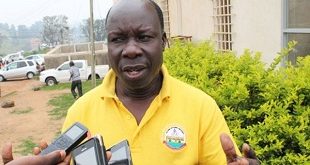What anniversary year says about the state of the monetary policy signal
COMMENT: Geoffrey A Onegi-Obel
The Bank of Uganda on August 2 and 3 capped a series of celebratory Golden Jubilee activities with the annual Joseph Mubiru Memorial Lecture and an Anniversary Day with President Yoweri Museveni as the chief guest.
While the series of public outreach events begun a process of demystifying the Bank of Uganda which is better known by ordinary Ugandans only as a ‘printer of currency’, this important 50 year milestone did not quite succeed in presenting a rigorous evaluation of the shape, depth, and direction of Banks Monetary Policy Signal over the next 50 years. This suggests the Bank is likely to continue punching well below its considerable latent capacity and power.
Indeed, the lecture topic by Dr Ngozi Okonjo-Iweala was instructive in asking the leading question of whether the Bank should ‘stay the course or not’.
Okonjo – Iweala proceeded to deliver a high level lecture which was at once global and regional in terms of African – only getting local when asked about the current Uganda ‘bail out’ proposition for interest rate distressed companies . Like the veteran economist she is, she advised ‘caution’ on this subject.
She was given a typical economists topic to discuss – wide enough so as not to be specific: ‘African Central Banks, Rethink Role or Stay the Course’.
It required her to only discuss challenges, even without offering solutions in terms of grounded and applied country specific options. The ‘discussants’ were supposed to come in and ground the lecture. This did not happen.
And so Okonjo -Iweala brilliantly excited us at the beginning by stating that this is “a good time to take stock of how far we have come and the challenges we confront as the journey continues”.
She correctly congratulated the Bank of Uganda on its relatively successful inflation targeting policies which have contained inflation and promoted price stability. Otherwise the main thrust of her presentation was global in outlook.
However given the global monetary policy references mentioned in the lecture (USA ,India etc.) there was no offering of any bouquet of options as solutions to the challenge of ‘jobless growth’ from the perspective of monetary policy – and by implication – fiscal policy. Instead, it appears, we got an economists cautious sub-Saharan Africa recommendation of “stay the course because the monetary and fiscal policy success of other parts of the world do not apply to countries like Uganda – and celebrate your average 6% GDP growth rates over the last decade as exemplary by Sub-Saharan African countries’. (My words).
I have always argued that any compliment based on sub-Sharan Africa standards and not global standards is like saying that in a class of non-performers (SSA) we are doing very well and we should celebrate. My view is let all our country analysis be based on global standards.
The 500,000 jobs a year reported is also debatable if only because, on a net basis and at below 7 percent GDP growth rates, the Uganda economy has been creating zero jobs per annum if the 3-2% annual population growth rates are factored.
In the search for sustainable solutions, the problems of job creating growth rates must be acknowledged, as well as the lack of depth of our financial sector reflected in our inverted yield curve – among other indicators.
Dr Okonjo –Iweala actually came close to offering a solution and answer to the issue. She said “African Central Banks need to define their strategy in conjunction with fiscal policy and structural reforms as they seek to control inflation and help promote inclusive growth”. But she cautioned: “The weight of experience points to being circumspect about unconventional monetary policy – that low and stable inflation which promotes our currency as a stable store of value to promote financial deepening and long run growth” is the way to go.
I could actually see Deputy Governor Louis Kasekende looking very satisfied on this point.
Unfortunately the discussants also did not pick on the need for financial sector deepening and what Dr Okonjo – Iwela called “long run growth”.
It is not good to critique without offering solutions in the form of options – so in my view the topic given to Dr Ngozi Okonjo – Iweala should have been framed as: “Where the Jobs Creating Annual GDP Growth Rate is 8 % and above for sub Saharan African countries like Uganda, how should the Bank of Uganda position the Monetary Policy Signal going forward to allow for sustained Growth with Jobs – and avoid Jobless Growth”. She was demonstrably very capable and well positioned to discuss it.
Framing the lecture topic this way would have not only helped our discussants to remain grounded (Nitin went as far back as the U.S. Depression), but also would have helped our own cerebral Kasekende who was provoked to wonder what the representative audience exactly wanted the Bank of Uganda to do going forward as a central bank.
I believe Kasekende (like Dr Okonjo- Iweala) is actually in position to answer his own question. But again, being the cautious economist he is, he wanted to hear something from the invited audience first, and then perhaps he would critique the contribution.
Perhaps having read Dr Okonjo-Iweala lecture notes, President Museveni in his remarks on the second and final day suggested that while inflation targeting was important, controlling inflation on its own was not enough.
So what am I saying?
We should revisit our Monetary Policy Signal and fine tune it for Jobs Creating Long Term Growth. This is the ‘inclusive growth’ Dr Okonjo-Iweala referred to and is also an imperative of the new Sustainable Development Goals (SDGs).
In other words any GDP Growth number must be engineered to generate Jobs.
If this means unconventional monetary policy –so be it.
Bank of Uganda Governor Tumusiime Mutebile actually had begun and launched the process of structured financial sector deepening through the now moribund Financial Markets Development Plan[FMDP1] – which included the crucial Bond Market Development Program designed to gradually ease the economy from its current expensive cash driven base to financial instruments of various types and tenor for intermediation.
Financial Sector Deepening means an economy presents different types of instruments for financial intermediation – and a growing Capital Markets industry presenting increasing secondary market trading. It also means a national payments system which does not look like the present cash based one we have.
In conclusion the Uganda Financial Services ecosystem as regulated by the Bank of Uganda is still at the very basic primary market products level. We should take the opportunity of the 50th Anniversary of the Bank of Uganda to take a fresh look at this financial services ecosystem with a view to repositioning the Uganda economy under the new SDGs where the standards are global and not sub-Saharan Africa. This is otherwise called growing up.
***
Dr Geoffrey A Onegi-Obel is an Investment Banker , and long serving director of the Uganda Securities Exchange Ltd which he founded with the support of the Bank of Uganda. (onegi_obel@use.or.ug)
***
editor@independent.co.ug
 The Independent Uganda: You get the Truth we Pay the Price
The Independent Uganda: You get the Truth we Pay the Price



